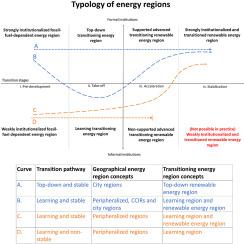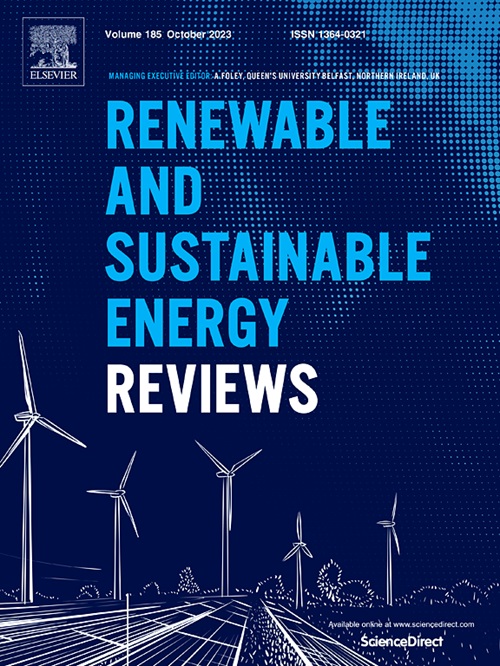引入能源区域类型学:系统文献综述
IF 16.3
1区 工程技术
Q1 ENERGY & FUELS
引用次数: 0
摘要
低碳能源转型正越来越多地在次国家或地区层面展开,从而形成能源区域。随着能源系统变得更加分散,国家政府将决策权下放给地方政府,形成了更多的能源区域。一些国家对能源区域进行了研究,但还没有研究对这些区域的多样性、转型过程和治理方法进行概述。重要的是要为全球其他案例(如煤炭和碳密集型地区)提供借鉴,了解哪些类型的地区以及它们是如何推动能源转型的。因此,本研究调查了 i) 已公布的能源地区概念,以及 ii) 能源地区在治理安排和创新过程方面的转型方式。本研究对十个国家的四十七篇学术出版物和三篇灰色文献报告进行了系统的文献综述。该综述涵盖三个学术(子)学科:即可持续性转型、区域研究和创新研究。研究结果显示了能源地区的五个概念:城市地区、边缘化地区、煤炭和碳密集型地区、学习型地区和可再生能源地区。所形成的类型显示了各地区可能遵循的转型路径。有趣的是,只有那些采用社会创新的能源地区才有可能增强其地区、组织和公民的能力。最后,为全球类似地区的实践者提出了建议,以帮助他们克服障碍,推进低碳转型。本文章由计算机程序翻译,如有差异,请以英文原文为准。

Introducing a typology of energy regions: A systematic literature review
Low-carbon energy transitions are being increasingly developed at sub-national or regional levels, forming, thus, energy regions. More energy regions have been formed as energy systems become more decentralized, and national governments devolve decision-making power to local authorities. Energy regions have been studied in several countries, but no study has yet overviewed these regions' variety, transition process, and governance approach. It is important to draw lessons for other cases worldwide, like coal and carbon-intensive regions, to understand what type of regions and how they have stimulated their energy transition. Thus, this study investigated i) the concepts of energy regions that have been published and ii) the way energy regions have transitioned in terms of governance arrangements and innovation processes. A systematic literature review was conducted covering forty-seven academic publications and three grey literature reports of energy regions in ten countries. This review covered three academic (sub-)disciplines: i.e. sustainability transitions, regional studies, and innovation studies. Results show five concepts of energy regions: city-regions, peripheralized regions, coal and carbon-intensive regions, learning regions, and renewable energy regions. The formed typology shows the possible transition pathways that regions can follow. Interestingly, only those energy regions that adopted social innovations had the potential to empower their region, its organizations, and its citizens. Finally, recommendations for practitioners in similar regions worldwide are outlined to help overcome obstacles and advance their low-carbon transition.
求助全文
通过发布文献求助,成功后即可免费获取论文全文。
去求助
来源期刊

Renewable and Sustainable Energy Reviews
工程技术-能源与燃料
CiteScore
31.20
自引率
5.70%
发文量
1055
审稿时长
62 days
期刊介绍:
The mission of Renewable and Sustainable Energy Reviews is to disseminate the most compelling and pertinent critical insights in renewable and sustainable energy, fostering collaboration among the research community, private sector, and policy and decision makers. The journal aims to exchange challenges, solutions, innovative concepts, and technologies, contributing to sustainable development, the transition to a low-carbon future, and the attainment of emissions targets outlined by the United Nations Framework Convention on Climate Change.
Renewable and Sustainable Energy Reviews publishes a diverse range of content, including review papers, original research, case studies, and analyses of new technologies, all featuring a substantial review component such as critique, comparison, or analysis. Introducing a distinctive paper type, Expert Insights, the journal presents commissioned mini-reviews authored by field leaders, addressing topics of significant interest. Case studies undergo consideration only if they showcase the work's applicability to other regions or contribute valuable insights to the broader field of renewable and sustainable energy. Notably, a bibliographic or literature review lacking critical analysis is deemed unsuitable for publication.
 求助内容:
求助内容: 应助结果提醒方式:
应助结果提醒方式:


